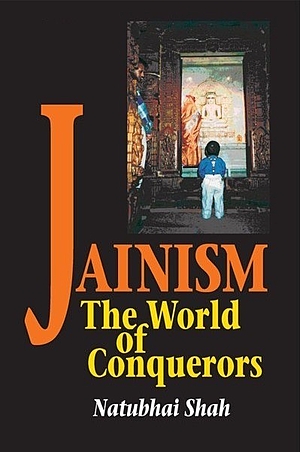The previous chapter described the Jain canonical and expositional literature largely written in ancient times, but with some as late as the 17th century CE. This chapter describes the literature of the modern period.
scribes the literature of the modern period. In the early literature the range of topics covered was relatively small, and it was either in Prakrit or Sanskrit, reflecting the fact that it was mainly intended for ascetics, and was understood by few lay people. To make it more accessible, it had to be translated into other languages, regional and foreign. Thus there was a period of intense translation work, which still continues: Gujarati, Hindi, Southern Indian languages, particularly Tamil and Kannada, and English were the major languages for modern translations.
The need for translations from Prakrit and Sanskrit resulted in the creation of a secondary literature devoted to linguistics and grammar, and the production of dictionaries and other scholarly aids.
Jain ascetics took an active part in this modern literary enterprise, writing explanatory, historical and ethical literature, as well as compilations of hymns, to promote and popularize Jainism. Some of this has been translated into foreign languages, including English, though in the Indian version rather than the Western idiom.
Jain research in universities is a modern phenomenon, still developing. Many, probably hundreds, of doctorates have been awarded for research in Jain subjects, mainly in India, some also abroad. But because of the lack of employment opportunities, it has remained difficult to attract bright students for a scholarly career.
Non-Jain scholars, including Indologists in Germany, the United Kingdom, and the United States have produced much of the recent academic literature on Jainism. Their work has included translations of the canon and the biographical and philosophical literature, and scientific scrutinisation of Jain concepts. For many centuries the great Jain libraries were restricted to monks, but a more liberal attitude on the part of Jains has resulted in Jain literature being more widely known and informative articles on Jainism now feature in books on world religions and in encyclopedias. The growing interest in Jainism has resulted in the participation of Jain scholars in national and international seminars and conferences.
Modern Biographical and Historical Literature
This literature is mainly translations of Prakrit, Sanskrit and Apabhramsa (a forerunner of Gujarati) epics and poetry. The Kalpa Sutra, mentioned earlier, is one such popular translation. A four-volume biography of Mahavira by Muni Ratnaprabha Vijay is one major example of a Jain publication.
Many institutions conduct research leading to publications in the field of Jain literary history. Among the most notable are: Parsvanatha Vidyaashram and Varni Shodh Sanshthan, both in Varanasi; Vidvat Parishad, Satna, in Madhya Pradesh; Bhartiya Jnanpith, in Delhi; Jain Visva Bharati Ladhnun in Rajasthan; Vishva Kalyan Prakashan Trust, Mehsana, and Satsrut Sadhana Kendra, Koba, and Lalbhai Dalpatbhai Institute of Indology, Ahmedabad, Gujarat.
Literature on Jain art and architecture through the ages has been published in many languages, including English and other non-Indian languages. The literature on Jain philosophy and history, and a number of biographical novels such as Anuttaryogi Mahavira (published in Hindi in four volumes between 1975 and 1980) and Mook Mati (Hindi in 1990), have been popular in India. The literature published is mainly in Gujarati and Hindi, and contains some children's literature based upon Jain myths, legends, biographies and values.
Ethics and Morality
The majority of the Jain canonical literature is ethical and spiritual in nature and during this century important scriptures have been translated and published in Hindi, Gujarati, and some in English and other Indian languages. The publications of the Jain Vishwa Bharati at Ladhnun are scholarly and modern in approach, as are those of the Agam Prakashan Samiti, Biyavar, the Visva Kalyan Prakasan Trust, Mehsana, the Mahavir Jain Vidyalaya, Mumbai, and the Bharatiya Jnanapitha, Delhi.
Unsurprisingly, given the earlier Jain reluctance to translate their scriptures, it first fell to a foreigner to undertake the task. At the end of the ninteenth century, the German scholar Hermann Jacobi began publishing translations and studies in English. In the last quarter of this century, many English translations of the scriptures have been published such as those by Lalvani on the Uttaraadhyayan Sutra, Kalpa Sutra, Dasaavaikaalika Sutra and Bhagvati Sutra, by the Bharatiya Jnanapitha on the Samyasaara and Pancaastikaayasaara and by many others on Tattvartha Sutra.
Most books concerning the conduct of ascetics and lay people are now available in modern Indian languages and in some in English. An example of note is 'Jain Yoga' by Williams on the conduct of the laity. The spiritual writings of the modern saint Shrimad Rajchandra (Raychandbhai Mehta, 1868-1901) have been published in most Indian languages and some in English. It is heartening to note that many publications on Jain themes are appearing every year for the last quarter of the century.
Devotional Literature
A large amount of devotional literature on hymns, on pujaa rituals and on consecration rituals has been produced over the last two centuries. Original and translated literature on penitential retreat (pratikramana), the popular ritual, has been published by many sources. Almost all the Sanskrit and Prakrit eulogies of the Jinas and others (stotras and similar) have been collected, translated and published; some newly composed hymns and eulogies on modern songs have also been published.
Many texts on the performing arts: music, dance and drama, based on religious themes, have also appeared. Jain migrants abroad, especially in the United Kingdom and United States, have produced dramatic scripts based on the lives of Mahavira and Neminatha, and have been performed on the stage, and these have been very popular in the Jain community.
Scientific, Technical and Mathematical Literature
The Jain scriptures contain a great deal of scientific material. Some scholars have researched Jain thinking and compared them with the modern sciences such as physics, chemistry, biology mathematics and astronomy. Mahaviracarya's book on Jain mathematics, written in the 12th century CE, has been translated into Hindi and English. Chapter five of the Tattvartha Sutra, which was translated into English in 1942, has had a scientific evaluation by G. R. Jain. Some subjects from the sacred books of scientific interest have been explored by the contemporary scholars on wide range of subjects, such as on mathematics (L.C. Jain), on the scientific contents in the canon (N. L. Jain), on astronomy (Lisk), on botany (Lodha) and on biology (Sikdar). Muni Mahendra and J. Zaveri have written on physics, neuroscience and meditation; Kamalaprabha Jain and D.C. Jain have written on economics; Chaudhary and Sharma have written on political science; and Mardia has published a book 'the scientific foundation of Jainism'.
Nowadays, meditation and yoga, two important practices of spiritual development, have also become the subjects of scientific investigation. Many scholars and Jain saints have published books in Hindi, Gujarati and English, discussing the science of Jain meditation and related religious practices.
Philosophy and Existence
Jain literature contains much material of human interest on philosophy including epistemology, ontology, logic and perception. Many modern scholars have researched the sacred texts and published the literature in English. Some of the works are: on philosophy by Tatia, M. Mehta and Devendra Muni (separately); on omniscience by Ramjisingh; on karma, separately by Arun Vijay, Mahaprajna and Von Glasenapp; on the theory of knowledge by Shastri and Bothra (separately); on the philosophy and the theory of holy death by C. Caillat, and on logic by Mahaprajna.
Other Literature
Other modern literature includes bibliographies, catalogues, encyclopaedias, dictionaries and glossaries. The bibliographies of Jain literature from Vir Sevamandir, Delhi, are important tools for Jain scholars. Encyclopaedias such as the Jainendra Siddhant Kosha have proved to be very useful. Jains have started to use modern technology and computers for the systematic study of Jain literature and research material, and one can find a sizeable amount of material on the Internet. Panyaasa Punya Vijay and other scholars have done the work of cataloguing the Sanskrit and Prakrit manuscripts. The Sevamandir, Jodhpur has published the catalogues of manuscripts and other books stored in the Jesalmir manuscript library, established in the 14th century. Jain scholars have also published Prakrit dictionaries and the glossaries of Jain terminology, which have been useful to academics. Recent articles in Encyclopaedia Britannica (1974: 22.247-253), The World's Religions (Reader's Digest 1993: pp.144-147) and World Religions (Bowker 1997: pp.42-53) have been very useful.
General books introducing Jainism to a wide audience, such as Jaini's 'The Jaina Path of Purification', Sanghave's 'Aspects of Jain Religion', Paul Dundas's 'The Jains' and Paul Marett's 'Jainism Explained' have proved popular among lay readers. Some Jain publications address issues of widespread contemporary concern, which include nonviolence and reverence for life, vegetarianism, animal welfare and environmental issues.
The modern period has seen the publication of Festschrift volumes in honour of ascetics, scholars and philanthropists. The author has been informed that more than 200 such volumes exist, varying in size from 200 pages to 3,600 pages. On major religious ceremonies, it is customary to publish souvenirs, which contain, material on the institution, the ceremony and articles on Jainism of general interest. The Mahavira Jain Vidhyalaya golden jubilee volume, the Jain Centre, Leicester, temple consecration publication, and the Atma Vallabha Smaraka, Delhi, temple consecration souvenir are representative of such literature. A large amount of literature on Mahavira was published during the 2,500th anniversary celebrations in 1969, and a volume appeared to commemorate the ceremony of anointing the colossal statue of Bahubali at Sravanbelgola in the 1980s.
Research literature on Jainism is published in certain academic journals; ten such journals exist in India. Conference proceedings have been a useful source of literature, they include 'The Assembly of Listeners' (Cambridge), 'Karmavada' (Calgary, Canada) and the 'World Jain Congress' (Leicester).
 Dr. Natubhai Shah
Dr. Natubhai Shah
